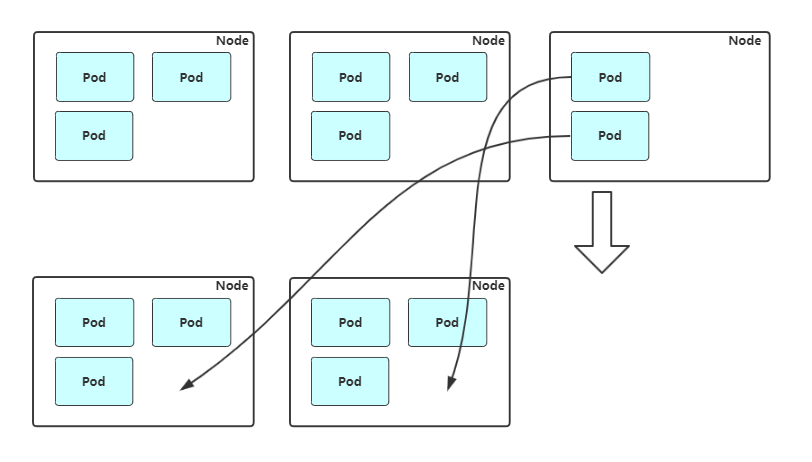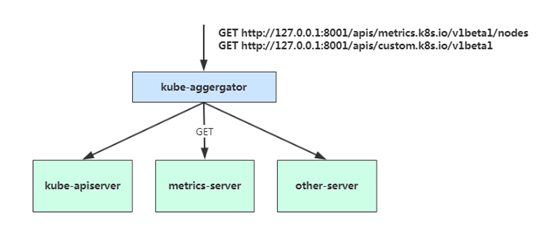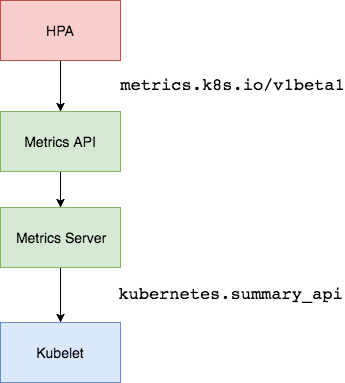-
cluster-autoscaler组件
-
HPA(Horizontal Pod Autoscaler):Pod个数自动扩/缩容
-
VPA(Vertical Pod Autoscaler):Pod配置自动扩/缩容,主要是CPU、内存
node自动扩容缩容
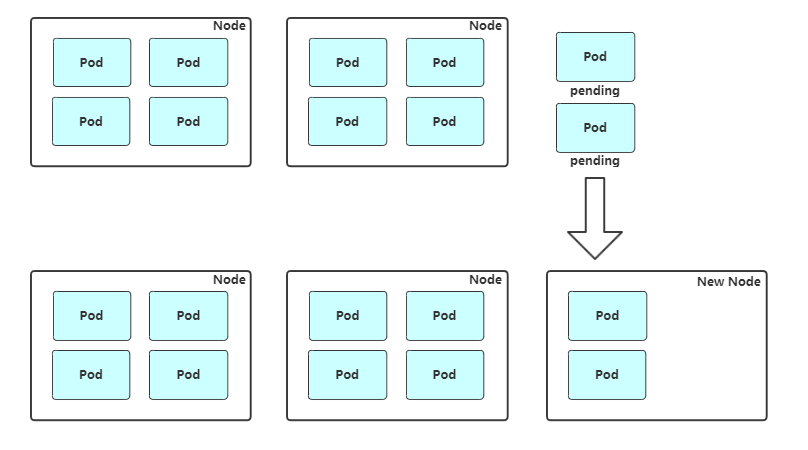
-
AWS: https://github.com/kubernetes/autoscaler/blob/master/cluster-autoscaler/cloudprovider/aws/README.md
-
Azure:
ansiable扩容node流程

1. 触发新增Node 2. 调用Ansible脚本部署组件 3. 检查服务是否可用 4. 调用API将新Node加入集群或者启用Node自动加入 5. 观察新Node状态 6. 完成Node扩容,接收新Pod
node缩容流程:
#获取节点列表 kubectl get node #设置不可调度 kubectl cordon $node_name #驱逐节点上的pod kubectl drain $node_name --ignore-daemonsets #移除节点 kubectl delete node $node_name
POD自动扩容缩容 (HPA)
Horizontal Pod Autoscaler(HPA,Pod水平自动伸缩),根据资源利用率或者自定义指标自动调整replication controller, deployment 或 replica set,实现部署的自动扩展和缩减,让部署的规模接近于实际服务的负载。HPA不适于无法缩放的对象,例如DaemonSet。
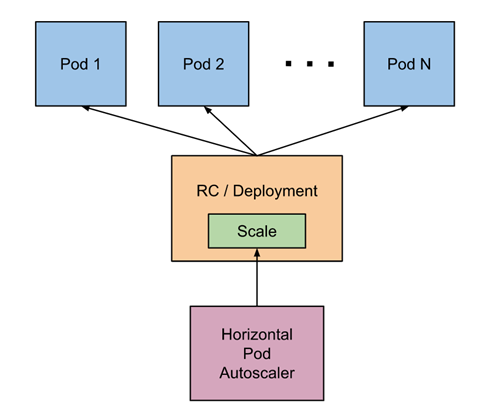
HPA基本原理
Kubernetes 中的 Metrics Server 持续采集所有 Pod 副本的指标数据。HPA 控制器通过 Metrics Server 的 API(Heapster 的 API 或聚合 API)获取这些数据,基于用户定义的扩缩容规则进行计算,得到目标 Pod 副本数量。当目标 Pod 副本数量与当前副本数量不同时,HPA 控制器就向 Pod 的副本控制器(Deployment、RC 或 ReplicaSet)发起 scale 操作,调整 Pod 的副本数量,完成扩缩容操作。如图所示。
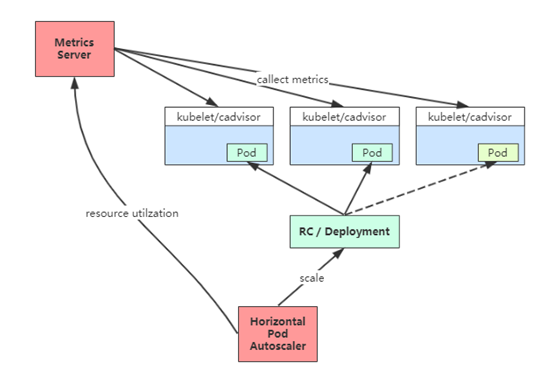
在 HPA 中,默认的扩容冷却周期是 3 分钟,缩容冷却周期是 5 分钟。
-
--horizontal-pod-autoscaler-downscale-delay :扩容冷却
-
HPA的演进历程:
目前大多数人比较熟悉是autoscaling/v1,这个版本只支持CPU一个指标的弹性伸缩。
而autoscaling/v2beta1增加了支持自定义指标,autoscaling/v2beta2又额外增加了外部指标支持。
#v1版本: apiVersion: autoscaling/v1 kind: HorizontalPodAutoscaler metadata: name: php-apache namespace: default spec: scaleTargetRef: apiVersion: apps/v1 kind: Deployment name: php-apache minReplicas: 1 maxReplicas: 10 targetCPUUtilizationPercentage: 50 #v2beta2版本: apiVersion: autoscaling/v2beta2 kind: HorizontalPodAutoscaler metadata: name: php-apache namespace: default spec: scaleTargetRef: apiVersion: apps/v1 kind: Deployment name: php-apache minReplicas: 1 maxReplicas: 10 metrics: - type: Resource resource: name: cpu target: type: Utilization averageUtilization: 50 - type: Pods pods: metric: name: packets-per-second target: type: AverageValue averageValue: 1k - type: Object object: metric: name: requests-per-second describedObject: apiVersion: networking.k8s.io/v1beta1 kind: Ingress name: main-route target: type: Value value: 10k - type: External external: metric: name: queue_messages_ready selector: "queue=worker_tasks" target: type: AverageValue averageValue: 30
基于CPU指标缩放
# vi /opt/kubernetes/cfg/kube-apiserver.conf ... --requestheader-client-ca-file=/opt/kubernetes/ssl/ca.pem --proxy-client-cert-file=/opt/kubernetes/ssl/server.pem --proxy-client-key-file=/opt/kubernetes/ssl/server-key.pem --requestheader-allowed-names=kubernetes --requestheader-extra-headers-prefix=X-Remote-Extra- --requestheader-group-headers=X-Remote-Group --requestheader-username-headers=X-Remote-User --enable-aggregator-routing=true ...
在设置完成重启 kube-apiserver 服务,就启用 API 聚合功能了。
Metric server从每个节点上Kubelet公开的摘要API收集指标。
# git clone https://github.com/kubernetes-incubator/metrics-server 修改deployment.yaml文件,修正集群问题 问题1:metrics-server默认使用节点hostname通过kubelet 10250端口获取数据,但是coredns里面没有该数据无法解析(10.96.0.10:53),可以在metrics server启动命令添加参数 --kubelet-preferred-address-types=InternalIP 直接使用节点IP地址获取数据 问题2:kubelet 的10250端口使用的是https协议,连接需要验证tls证书。可以在metrics server启动命令添加参数--kubelet-insecure-tls不验证客户端证书 问题3:yaml文件中的image地址k8s.gcr.io/metrics-server-amd64:v0.3.0 需要梯子,需要改成中国可以访问的image地址,可以使用aliyun的。这里使用hub.docker.com里的google镜像地址 image: mirrorgooglecontainers/metrics-server-amd64:v0.3.1 kubectl apply -f . kubectl get pod -n kube-system
kubectl get --raw /apis/metrics.k8s.io/v1beta1/nodes
kubectl top node
kubectl get apiservice |grep metrics
kubectl describe apiservice v1beta1.metrics.k8s.io
创建HPA策略:
# kubectl get pod NAME READY STATUS RESTARTS AGE java-demo-8548998c57-d4wkp 1/1 Running 0 12m java-demo-8548998c57-w24x6 1/1 Running 0 11m java-demo-8548998c57-wbnrs 1/1 Running 0 11m # kubectl autoscale deployment java-demo --cpu-percent=50 --min=3 --max=10 --dry-run -o yaml > hpa-v1.yaml # cat hpa-v1.yaml apiVersion: autoscaling/v1 kind: HorizontalPodAutoscaler metadata: name: java-demo spec: maxReplicas: 10 minReplicas: 3 scaleTargetRef: apiVersion: apps/v1 kind: Deployment name: java-demo targetCPUUtilizationPercentage: 50 # kubectl apply -f hpa-v1.yaml # kubectl get hpa NAME REFERENCE TARGETS MINPODS MAXPODS REPLICAS AGE java-demo Deployment/java-demo 1%/50% 3 10 3 10m # kubectl describe hpa java-demo
# yum install httpd-tools -y # kubectl get svc NAME TYPE CLUSTER-IP EXTERNAL-IP PORT(S) AGE java-demo ClusterIP 10.0.0.215 <none> 80/TCP 171m # ab -n 100000 -c 100 http://10.0.0.215/index This is ApacheBench, Version 2.3 <$Revision: 1430300 $> Copyright 1996 Adam Twiss, Zeus Technology Ltd, http://www.zeustech.net/ Licensed to The Apache Software Foundation, http://www.apache.org/ Benchmarking 10.0.0.215 (be patient) Completed 10000 requests Completed 20000 requests Completed 30000 requests Completed 40000 requests Completed 50000 requests Completed 60000 requests Completed 70000 requests Completed 80000 requests apr_socket_recv: Connection refused (111) Total of 85458 requests completed
检测扩容状态
# kubectl get hpa NAME REFERENCE TARGETS MINPODS MAXPODS REPLICAS AGE java-demo Deployment/java-demo 1038%/50% 3 10 10 165m # kubectl get pod NAME READY STATUS RESTARTS AGE java-demo-77d4f5cdcf-4chv4 1/1 Running 0 56s java-demo-77d4f5cdcf-9bkz7 1/1 Running 0 56s java-demo-77d4f5cdcf-bk9mk 1/1 Running 0 156m java-demo-77d4f5cdcf-bv68j 1/1 Running 0 41s java-demo-77d4f5cdcf-khhlv 1/1 Running 0 41s java-demo-77d4f5cdcf-nvdjh 1/1 Running 0 56s java-demo-77d4f5cdcf-pqxvb 1/1 Running 0 41s java-demo-77d4f5cdcf-pxgl9 1/1 Running 0 41s java-demo-77d4f5cdcf-qqk6q 1/1 Running 0 156m java-demo-77d4f5cdcf-tkct6 1/1 Running 0 156m # kubectl top pod NAME CPU(cores) MEMORY(bytes) java-demo-77d4f5cdcf-4chv4 2m 269Mi java-demo-77d4f5cdcf-bk9mk 2m 246Mi java-demo-77d4f5cdcf-cwzwz 2m 177Mi java-demo-77d4f5cdcf-cz7hj 3m 220Mi java-demo-77d4f5cdcf-fb9zl 3m 197Mi java-demo-77d4f5cdcf-ftjht 3m 194Mi java-demo-77d4f5cdcf-qdxqf 2m 174Mi java-demo-77d4f5cdcf-qx52w 2m 175Mi java-demo-77d4f5cdcf-rfrlh 3m 220Mi java-demo-77d4f5cdcf-xjzjt 2m 176Mi
工作流程:hpa -> apiserver -> kube aggregation -> metrics-server -> kubelet(cadvisor)
apiVersion: autoscaling/v2beta2 kind: HorizontalPodAutoscaler metadata: name: java-demo namespace: default spec: scaleTargetRef: apiVersion: apps/v1 kind: Deployment name: web minReplicas: 1 maxReplicas: 10 metrics: - resource: type: Resource name: cpu target: averageUtilization: 60 type: Utilization
type: Pods pods: metric: name: packets-per-second target: type: AverageValue averageValue: 1k
type: Object object: metric: name: requests-per-second describedObject: apiVersion: networking.k8s.io/v1beta1 kind: Ingress name: main-route target: type: Value value: 2k
-
-
Object:指的是指定k8s内部对象的指标,数据需要第三方adapter提供,只支持Value和AverageValue类型的目标值。
-
Pods:指的是伸缩对象Pods的指标,数据需要第三方的adapter提供,只允许AverageValue类型的目标值。
-
apiVersion: autoscaling/v2beta2 kind: HorizontalPodAutoscaler metadata: name: java-demo namespace: default spec: scaleTargetRef: apiVersion: apps/v1 kind: Deployment name: java-demo minReplicas: 1 maxReplicas: 10 metrics: - type: Resource resource: name: cpu target: type: Utilization averageUtilization: 50 - type: Pods pods: metric: name: packets-per-second target: type: AverageValue averageValue: 1k - type: Object object: metric: name: requests-per-second describedObject: apiVersion: networking.k8s.io/v1beta1 kind: Ingress name: main-route target: type: Value value: 10k
资源指标只包含CPU、内存,一般来说也够了。但如果想根据自定义指标:如请求qps/5xx错误数来实现HPA,就需要使用自定义指标了,目前比较成熟的实现是 Prometheus Custom Metrics。自定义指标由Prometheus来提供,再利用k8s-prometheus-adpater聚合到apiserver,实现和核心指标(metric-server)同样的效果。
工作流程:hpa -> apiserver -> kube aggregation -> prometheus-adapter -> prometheus -> pods
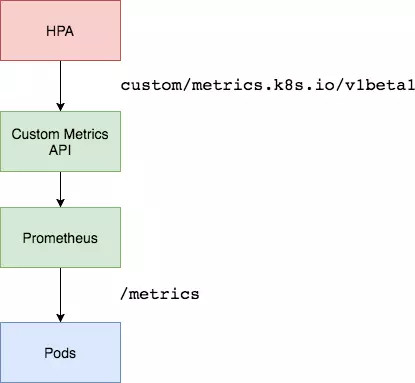
https://github.com/DirectXMan12/k8s-prometheus-adapter
该 PrometheusAdapter 有一个稳定的Helm Charts,我们直接使用。
wget https://get.helm.sh/helm-v3.0.0-linux-amd64.tar.gz tar zxvf helm-v3.0.0-linux-amd64.tar.gz mv linux-amd64/helm /usr/bin/ helm repo add stable http://mirror.azure.cn/kubernetes/charts helm repo update helm repo list
部署prometheus-adapter,指定prometheus地址:
# helm install prometheus-adapter stable/prometheus-adapter --namespace kube-system --set prometheus.url=http://prometheus.kube-system,prometheus.port=9090 # helm list -n kube-system NAME NAMESPACE REVISION UPDATED STATUS CHART APP VERSION prometheus-adapter kube-system 1 2020-05-28 11:38:35.156622425 +0800 CST deployed prometheus-adapter-2.3.1 v0.6.0
确保适配器注册到APIServer:
# kubectl get apiservices |grep custom # kubectl get --raw "/apis/custom.metrics.k8s.io/v1beta1"
基于QPS指标实践
部署应用暴露prometheus指标接口,可以通过访问service看到
apiVersion: apps/v1 kind: Deployment metadata: labels: app: metrics-app name: metrics-app spec: replicas: 3 selector: matchLabels: app: metrics-app template: metadata: labels: app: metrics-app annotations: prometheus.io/scrape: "true" prometheus.io/port: "80" prometheus.io/path: "/metrics" spec: containers: - image: lizhenliang/metrics-app name: metrics-app ports: - name: web containerPort: 80 resources: requests: cpu: 200m memory: 256Mi readinessProbe: httpGet: path: / port: 80 initialDelaySeconds: 3 periodSeconds: 5 livenessProbe: httpGet: path: / port: 80 initialDelaySeconds: 3 periodSeconds: 5 --- apiVersion: v1 kind: Service metadata: name: metrics-app labels: app: metrics-app spec: ports: - name: web port: 80 targetPort: 80 selector: app: metrics-app # curl 10.99.15.240/metrics # HELP http_requests_total The amount of requests in total # TYPE http_requests_total counter http_requests_total 86 # HELP http_requests_per_second The amount of requests per second the latest ten seconds # TYPE http_requests_per_second gauge http_requests_per_second 0.5
创建HPA策略
使用Prometheus提供的指标测试来测试自定义指标(QPS)的自动缩放。
# vi app-hpa-v2.yml apiVersion: autoscaling/v2beta2 kind: HorizontalPodAutoscaler metadata: name: metrics-app-hpa namespace: default spec: scaleTargetRef: apiVersion: apps/v1 kind: Deployment name: metrics-app minReplicas: 1 maxReplicas: 10 metrics: - type: Pods pods: metric: name: http_requests_per_second target: type: AverageValue averageValue: 800m # 800m 即0.8个/秒
# kubectl edit cm prometheus-adapter -n kube-system apiVersion: v1 kind: ConfigMap metadata: labels: app: prometheus-adapter chart: prometheus-adapter-v0.1.2 heritage: Tiller release: prometheus-adapter name: prometheus-adapter data: config.yaml: | rules: - seriesQuery: 'http_requests_total{kubernetes_namespace!="",kubernetes_pod_name!=""}' resources: overrides: kubernetes_namespace: {resource: "namespace"} kubernetes_pod_name: {resource: "pod"} name: matches: "^(.*)_total" as: "${1}_per_second" metricsQuery: 'sum(rate(<<.Series>>{<<.LabelMatchers>>}[2m])) by (<<.GroupBy>>)' ...
kubectl get --raw "/apis/custom.metrics.k8s.io/v1beta1/namespaces/default/pods/*/http_requests_per_second"
压测
ab -n 100000 -c 100 http://10.99.15.240/metrics
查看PHA状态
kubectl get hpa
kubectl describe hpa metrics-app-hpa
小结
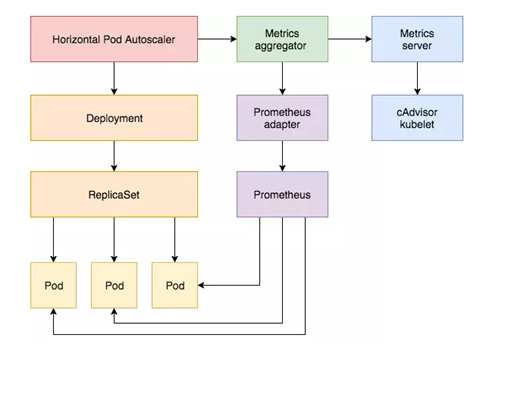
-
-
prometheus将收集到的信息汇总;
-
APIServer定时从Prometheus查询,获取request_per_second的数据;
-
HPA定期向APIServer查询以判断是否符合配置的autoscaler规则;
-
